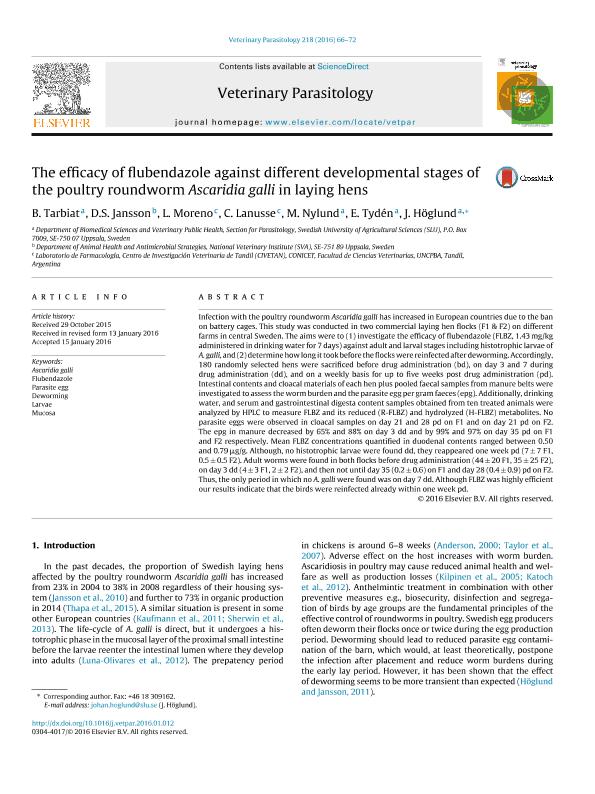Mostrar el registro sencillo del ítem
dc.contributor.author
Tarbiat, B.
dc.contributor.author
Jansson, D. S.
dc.contributor.author
Moreno, Laura Susana

dc.contributor.author
Lanusse, Carlos Edmundo

dc.contributor.author
Nylund, M.
dc.contributor.author
Tydén, E.
dc.contributor.author
Höglund, J.
dc.date.available
2018-09-05T20:13:35Z
dc.date.issued
2016-03
dc.identifier.citation
Tarbiat, B.; Jansson, D. S.; Moreno, Laura Susana; Lanusse, Carlos Edmundo; Nylund, M.; et al.; The efficacy of flubendazole against different developmental stages of the poultry roundworm Ascaridia galli in laying hens; Elsevier Science; Veterinary Parasitology; 218; 3-2016; 66-72
dc.identifier.issn
0304-4017
dc.identifier.uri
http://hdl.handle.net/11336/58436
dc.description.abstract
Infection with the poultry roundworm Ascaridia galli has increased in European countries due to the ban on battery cages. This study was conducted in two commercial laying hen flocks (F1 & F2) on different farms in central Sweden. The aims were to (1) investigate the efficacy of flubendazole (FLBZ, 1.43 mg/kg administered in drinking water for 7 days) against adult and larval stages including histotrophic larvae of A. galli, and (2) determine how long it took before the flocks were reinfected after deworming. Accordingly, 180 randomly selected hens were sacrificed before drug administration (bd), on day 3 and 7 during drug administration (dd), and on a weekly basis for up to five weeks post drug administration (pd). Intestinal contents and cloacal materials of each hen plus pooled faecal samples from manure belts were investigated to assess the worm burden and the parasite egg per gram faeces (epg). Additionally, drinking water, and serum and gastrointestinal digesta content samples obtained from ten treated animals were analyzed by HPLC to measure FLBZ and its reduced (R-FLBZ) and hydrolyzed (H-FLBZ) metabolites. No parasite eggs were observed in cloacal samples on day 21 and 28 pd on F1 and on day 21 pd on F2. The epg in manure decreased by 65% and 88% on day 3 dd and by 99% and 97% on day 35 pd on F1 and F2 respectively. Mean FLBZ concentrations quantified in duodenal contents ranged between 0.50 and 0.79 μg/g. Although, no histotrophic larvae were found dd, they reappeared one week pd (± 7 F1, 0.5 ± 0.5 F2). Adult worms were found in both flocks before drug administration (44 ± 20 F1, 35 ± 25 F2), on day 3 dd (± 3 F1, 2 ± 2 F2), and then not until day 35 (0.2 ± 0.6) on F1 and day 28 (0.4 ± 0.9) pd on F2. Thus, the only period in which no A. galli were found was on day 7 dd. Although FLBZ was highly efficient our results indicate that the birds were reinfected already within one week pd.
dc.format
application/pdf
dc.language.iso
eng
dc.publisher
Elsevier Science

dc.rights
info:eu-repo/semantics/openAccess
dc.rights.uri
https://creativecommons.org/licenses/by-nc-nd/2.5/ar/
dc.subject
Ascaridia Galli
dc.subject
Deworming
dc.subject
Flubendazole
dc.subject
Larvae
dc.subject
Mucosa
dc.subject
Parasite Egg
dc.subject.classification
Otras Ciencias Veterinarias

dc.subject.classification
Ciencias Veterinarias

dc.subject.classification
CIENCIAS AGRÍCOLAS

dc.title
The efficacy of flubendazole against different developmental stages of the poultry roundworm Ascaridia galli in laying hens
dc.type
info:eu-repo/semantics/article
dc.type
info:ar-repo/semantics/artículo
dc.type
info:eu-repo/semantics/publishedVersion
dc.date.updated
2018-09-05T15:51:34Z
dc.journal.volume
218
dc.journal.pagination
66-72
dc.journal.pais
Países Bajos

dc.journal.ciudad
Amsterdam
dc.description.fil
Fil: Tarbiat, B.. Swedish University of Agricultural Sciences; Suecia
dc.description.fil
Fil: Jansson, D. S.. National Veterinary Institute; Suecia
dc.description.fil
Fil: Moreno, Laura Susana. Consejo Nacional de Investigaciones Científicas y Técnicas. Centro Científico Tecnológico Conicet - Tandil. Centro de Investigación Veterinaria de Tandil. Universidad Nacional del Centro de la Provincia de Buenos Aires. Centro de Investigación Veterinaria de Tandil. Provincia de Buenos Aires. Gobernación. Comision de Investigaciones Científicas. Centro de Investigación Veterinaria de Tandil; Argentina
dc.description.fil
Fil: Lanusse, Carlos Edmundo. Consejo Nacional de Investigaciones Científicas y Técnicas. Centro Científico Tecnológico Conicet - Tandil. Centro de Investigación Veterinaria de Tandil. Universidad Nacional del Centro de la Provincia de Buenos Aires. Centro de Investigación Veterinaria de Tandil. Provincia de Buenos Aires. Gobernación. Comision de Investigaciones Científicas. Centro de Investigación Veterinaria de Tandil; Argentina
dc.description.fil
Fil: Nylund, M.. Swedish University of Agricultural Sciences; Suecia
dc.description.fil
Fil: Tydén, E.. Swedish University of Agricultural Sciences; Suecia
dc.description.fil
Fil: Höglund, J.. Swedish University of Agricultural Sciences; Suecia
dc.journal.title
Veterinary Parasitology

dc.relation.alternativeid
info:eu-repo/semantics/altIdentifier/doi/http://dx.doi.org/10.1016/j.vetpar.2016.01.012
dc.relation.alternativeid
info:eu-repo/semantics/altIdentifier/url/https://www.sciencedirect.com/science/article/pii/S0304401716300127
Archivos asociados
